La Sportiva Jackal
Test Location: Gunnison, Colorado
Test Duration: 94 mi
Stated Stack Height: 25 mm (heel) / 18 mm (forefoot)
Stated Heel-to-Toe Drop: 7 mm
Stated Features:
Designed for long-distance trail running, with exceptional cushioning and a wider fit
Combination of EVA and Infinitoo™ PU inserts in midsole for long-distance cushion and trail stability
Outsole: FriXion XT 2.0 / FriXion Red rubber compound for traction and durability
Near-seamless upper reduces hot spots
Dual density rock guard throughout shoe for underfoot protection
MSRP: $140
Size Tested: US Men’s 12 / EU 45 ½
Stated Weight per Shoe (US Men’s Size 9): 300 g / 10.5 oz
Blister Measured Weight per Shoe (US Men’s Size 12): 365.5 g / 12.9 oz
Reviewer (see running profile): 6’1”, 145 lbs
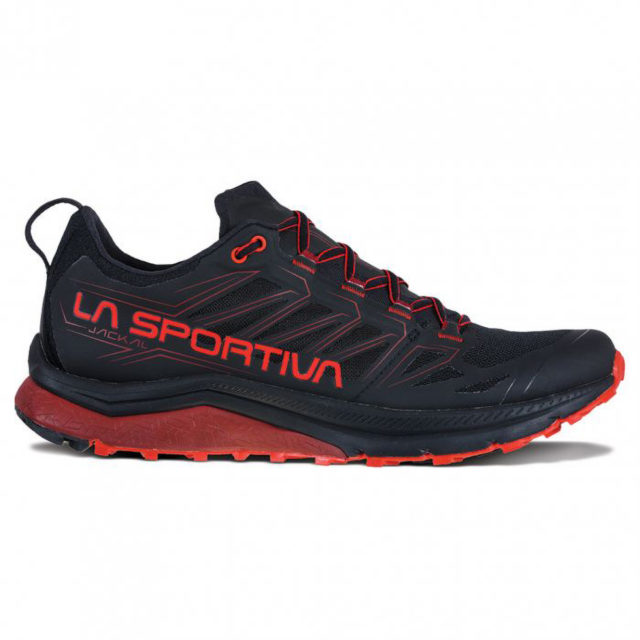
Intro
What makes a truly awesome shoe for long runs and races? Obviously, the answer will be different for everyone, depending on your foot shape and preferences, but most brands seem to think that it’s some combination of a wider fit, softer cushioning, and additional support vs. shorter-distance shoes.
La Sportiva has tried their hand in the ultra-specific category multiple times with shoes like the Akasha and Unika, but I’ve never felt that they’ve totally nailed the fit and ride that I personally like for long runs / races, compared to shoes from some other brands that I’ve used.
With that in mind, I was curious to give the new La Sportiva Jackal a try. The Jackal combines features from La Sportiva’s previous long-distance specific shoes to provide a moderately cushioned ride and wider fit that the brand claims will “meet the expectations of long-distance trail runners.” So, does the Jackal live up to expectations? I’ve been both running and hiking in the Jackal for a few months now, and I think that, for the most part, the answer is yes — at least for some runners and applications.
Fit
I’ve said it before, but it’s especially important to try on shoes in person before you buy if you’re considering a pair of La Sportiva shoes. I wear a US Men’s 11.5 in just about every shoe, but I consistently have to size up a half or even a full size in La Sportiva’s shoes. The Jackal is no exception — I’ve been using a US Men’s 12, and if anything, it’s a little on the small side. So if you are looking to buy a pair of Jackals, I’d recommend trying on at least a half size up from your normal shoe size.
Sizing aside, the Jackal’s fit is excellent for my feet and my preferences. For reference, I’ve got fairly narrow, low-volume feet and like shoes with a secure midfoot and wider forefoot. The Jackal pretty much fits that description and has an elastic, gusseted tongue that wraps the midfoot and provides a solid, locked-down fit that makes the shoe feel much more secure on technical terrain than a wider shoe like the Altra Timp 2.0.
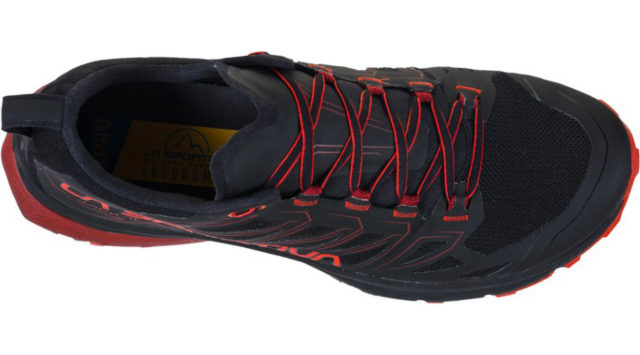
On top of that, the Jackal’s toebox is both wider and more rounded than any other La Sportiva shoe I’ve used. Shoes like the Lycan II still have a fairly pointed toebox when viewed from the top, but the front of the Jackal’s toebox doesn’t narrow nearly as much towards the front. It’s still not as wide as the toebox on most Altra shoes, but the Jackal does provide quite a bit more room for toe splay than shoes like the La Sportiva Lycan II or Salomon S/Lab Ultra 2. The Jackal’s fit through the midfoot feels fairly similar to the Salomon S/Lab Ultra 2 or Nike Terra Kiger 5: locked down, but not overly tight / restrictive. The net result is a fit that’s secure but comfortable, even after a full day in the shoe. My toes did start to feel a bit squished on a long downhill at the end of a 10-hour hike in the Jackal, but I think that was more of a sizing issue than a fit issue — as I mentioned at the top, my US Men’s size 12s feel a bit tighter than I’d prefer. My guess is that if I sized up another half size, this issue would go away.
I haven’t experienced any hot spots or rubbing in the Jackal, but the heel cup might cause some issues for some runners. The back of the heel comes up a few millimeters higher and lacks the Achilles “notch” compared to most shoes I’ve used. I personally haven’t had any trouble with the Jackal’s higher heel, but I’ve heard complaints that it causes some unnecessary discomfort for runners with tender Achilles tendons.
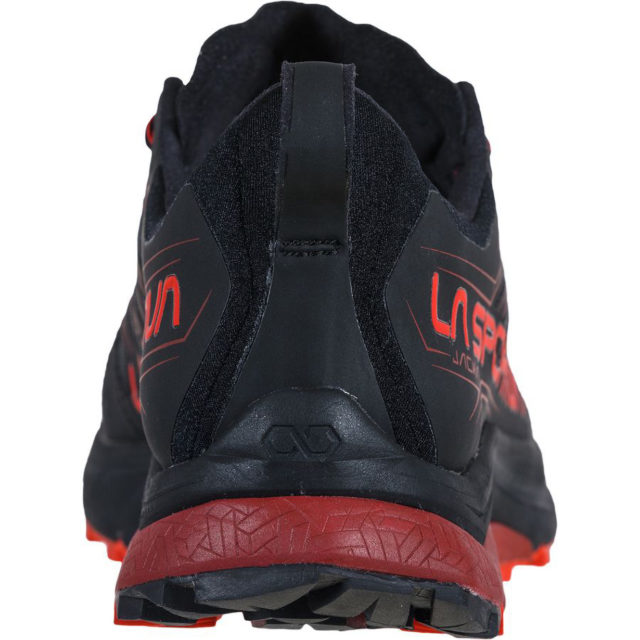
Weight
In general, most long-distance-specific trail shoes prioritize optimal comfort, cushion, and support over minimum weight. The Jackal certainly follows this trend — with a stated weight of 300 g / 10.5 oz for a US Men’s size 9, it’s one of the heavier shoes I’ve recently used. And even though the Jackal’s main competitors from other brands aren’t necessarily ultra-lightweight shoes, the Jackal does weigh more than most other similar shoes on the market. For reference, here’s how the Jackal compares to the stated weights of some long-distance-oriented shoes from a variety of other brands. All weights are based on a US Men’s size 9:
258 g / 9.1 oz — Arc’teryx Norvan LD 2
258 g / 9.1 oz — Hoka One One Torrent 2
270 g / 9.5 oz — Inov-8 Terraultra G 270
281 g / 9.9 oz — Altra Timp 2.0
286 g / 10.1 oz — Topo Athletic Ultraventure
290 g / 10.2 oz — Salomon S/Lab Ultra 3
290 g / 10.2 oz — Brooks Caldera 4
300 g / 10.5 oz — La Sportiva Jackal
303 g / 10.7 oz — Saucony Peregrine 10
Before anyone runs away screaming to buy a lighter shoe, there are a few important considerations and tradeoffs when it comes to the Jackal’s weight. First off, the Jackal isn’t massively heavier than shoes like the Brooks Caldera 4 or Salomon S/Lab Ultra 3 — 10 g / 0.3 oz is a small enough difference that I’d expect those shoes to feel pretty similar on the trail as far as weight is concerned. Second, if you’re doing a particularly long run or race, most people will probably be more concerned about comfort and protection than minimizing weight. And finally, the Jackal doesn’t seem unnecessarily heavy — the upper is a bit more structured than more minimal shoes, and the full-rubber outsole definitely adds some weight, but these features make sense from a durability and support standpoint for a long-distance-oriented shoe.
So, from an objective standpoint, I get why the Jackal is a little on the heavy side. With that said, I’d still be happier with the shoe if it was a bit lighter. This is just personal preference, but if I’m going on a long run, I don’t want to feel weighed down by my shoes — even if that extra weight is making them more durable and supportive. The Jackal doesn’t necessarily feel super heavy or cumbersome on the trail, but it does feel noticeably heavier than the Altra Timp 2.0. Personally, I think the Jackal would be a more appealing option for ultra-distance races if it shed some weight, but some of this comes down to personal preference.
Upper
The Jackal has a fairly standard mesh upper with synthetic overlays and a beefy TPU toecap. The tongue is fairly thin, but provides enough cushion to keep the laces from digging into the tops of my feet. It’s also anchored to the midsole with elastic gussets, which keep the tongue from sliding around and contribute to the shoe’s secure fit.
All in all, I’d describe the Jackal’s upper as simple and effective. There aren’t any super fancy materials, weird lacing geometries, or extra features — and I think that’s a good thing. The Jackal’s upper is comfortable, breathable, and secure. I’ve never had any hot spots or blisters from the shoe, and the upper breathes well enough to keep my feet comfortable even in hot weather. It also seems plenty durable, although I haven’t really put enough miles in the shoe to draw any final conclusions about that.

The one quirk about the Jackal’s upper is the high heel cup that I touched on in the Fit section. Rather than the small notch in the middle of the heel found in most shoes, the Jackal’s heel cup extends up the back of the heel a few extra millimeters. Again, I haven’t had any issues with this, but it does put a bit more pressure on your Achilles Tendon — so if you tend to be sensitive in that area, it could cause some problems.
Midsole
I’m always been entertained by La Sportiva’s jargon-heavy midsole technologies, and the Jackal is certainly no exception. Its midsole consists of a mix of compressed EVA and the brand’s “Infinitoo™ PU inserts.” La Sportiva claims this combo gives the shoe a mix of cushion and stability, which sounds great, but I had no idea what Infinitoo PU inserts actually were. As it turns out, they basically just consist of a different type of midsole foam that’s polyurethane-based rather than ethylene / vinyl-based like a standard EVA foam. According to La Sportiva, Infinitoo is softer than most EVA foams, but also provides better energy return and compression resistance.
For once, I actually do think I could feel the difference between the Jackal’s fancy midsole material and other shoes I’ve run in with more “standard” EVA midsoles. The Jackal’s midsole still has a significant amount of regular old EVA foam, but the Infinitoo PU inserts in the heel and forefoot do seem to give it a slightly more springy, energetic feel than shoes like the Altra Timp 2.0, which uses a modified EVA foam for its midsole. (Of course, EVA and PU can vary a lot depending on how exactly they’re made, so the main point is just that the Jackal has a fairly energetic feel.)
When compared to a lot of other long-distance-specific shoes, the Jackal actually has a fairly low stack height. With 25 mm of cushioning in the heel and 18 mm in the toe, the Jackal is definitely not a high-cushion shoe like the Altra Timp 2.0 (29 mm heel / 29 mm toe) or Hoka One One Evo Speedgoat (32 mm heel / 28 mm forefoot). But thanks to the springy Infinitoo cushioning and full-length rock plate, the Jackal still feels plenty cushioned and protective for my longer outings. I haven’t had any issues with foot fatigue in the Jackal, even after wearing the shoe all day.
Outsole
The Jackal uses La Sportiva’s FriXion XT 2.0 (also known as FriXion “Red”) rubber compound for the outsole, which is the brand’s “all-round,” dual-compound outsole material. It’s not quite as sticky as the FriXion XF rubber found on many of the brand’s mud shoes, but it’s much more durable. True to form, I’ve found that the Jackal’s outsole performs well on a wide variety of terrain. It’s got fairly wide, 3mm-deep directional lugs that grip well on hardpack, rock, and slightly loose or wet terrain.
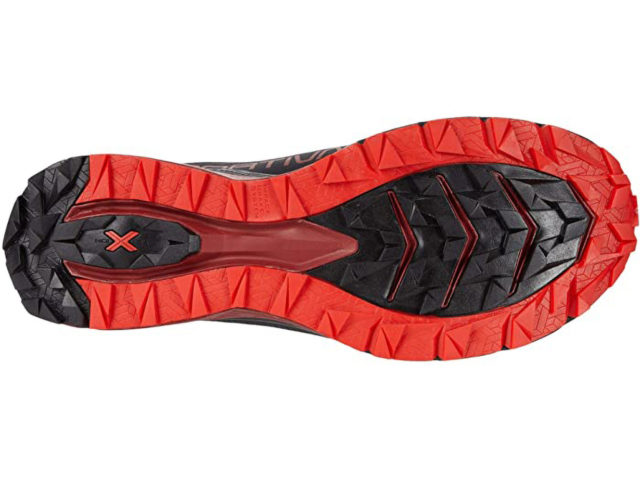
Because the Jackal’s lugs are broader than the narrower, cleat-like lugs you’d find on most mud shoes, the Jackal doesn’t offer a ton of grip in deep mud or super loose, sandy terrain, but it has plenty of grip for most other surfaces. The Jackal’s outsole also has a series of flex grooves that allow the shoe to flex much more than some of La Sportiva’s stiffer shoes, like the Bushido II. The Jackal still isn’t as flexible as the Altra Timp 2.0, but it does have enough give to it that it feels fairly smooth and efficient on non-technical terrain.
On Trail
I’ve been coming off an injury for the last few weeks, so most of my runs so far in the Jackal have been fairly short (an hour or less). But I’ve also worn the Jackal for several full days of hiking on a variety of terrain, so I’ve been able to get a pretty good sense of how they perform on longer outings as well. I’ll be updating this section of the review once I’ve had the chance to wear the Jackal for some longer runs.
My go-to shoe for long runs has been the Altra Timp 2.0 for most of this year, so I was especially curious to see how the Jackal would compare — especially on long days in the shoe. For the most part, I think the Jackal is a solid shoe for longer days, especially on more technical terrain.
Personally, I prefer shoes with fairly soft cushioning and ample space in the toebox for long runs, which is why I’ve gotten along so well with the Timp 2.0. The Jackal isn’t quite as wide or as plush as the Timp 2.0, but it does offer enough space and cushioning that it still feels comfy at the end of a ten-hour day of hiking.
As I mentioned in the “Fit” section, the Jackal has a much more rounded toebox than any other La Sportiva shoe I’ve run in. Its toebox still isn’t super wide, but the rounded shape alone gives my toes ample space. The overall fit is a bit lower volume than the Altra Timp 2.0, but the Jackal does feel more spacious than the Hoka One One Evo Speedgoat, which makes it more comfortable for my preferences.
As far as cushioning goes, I’ve been impressed with how much cushion and support the Jackal provides, considering its relatively low stack height. As I’ve discussed, the Jackal has an energetic ride that feels efficient on both short runs on smooth terrain and long hike / runs on rugged mountain trails. The lower stack height does make the Jackal feel significantly less plush than the Altra Timp 2.0 or Hoka Evo Speedgoat, but it does feel more cushioned and protective than shoes like the Nike Terra Kiger 5 or Salomon Sense 4 /Pro. I think this puts the Jackal in a pretty versatile middle ground in terms of cushioning.
The Jackal also feels much more stable on off-camber, technical terrain than some of my other usual long-run shoe options like the Timp 2.0. Part of this stability stems from the Jackal’s lower-volume fit, which keeps my foot from sliding around inside the shoe on rough terrain. The Jackal’s lower stack height also eliminates the unstable, “tippy” feel of some maximal shoes on rocky, steep trails. The Jackal’s midsole also flares out around the heel so that the outsole is actually a few millimeters wider than the footbed, which contributes to a stable, confidence-inspiring ride.
My two complaints about the Jackal’s performance on the trail are pretty much just matters of personal preference: weight and drop. As I’ve said, the Jackal isn’t a very light shoe — especially considering its fairly low stack height. There are some good reasons for some of that extra weight (ample support, burly outsole, extra durability, etc.), but that doesn’t change the fact that the Jackal feels noticeably heavier than the shoes I’m used to running in. The extra weight isn’t a huge problem on long, slow runs, but it is much more noticeable at faster paces. If it was a bit lighter and faster-feeling, I’d say that the Jackal would make a great shoe for shorter ultras and rugged trail races. But as is, I wouldn’t want to wear it for any run where speed is a priority.
The Jackal’s 7 mm drop is also slightly on the higher end of what I personally prefer, especially for steep, technical downhills. I think shoes with a ~4 mm drop or less feel much more stable and natural on rocky downhills, and I can definitely tell that the Jackal has a bit more drop than I’m used to. I’m usually a forefoot or midfoot striker, and I can still run pretty much normally in the Jackal on flat terrain and uphills, but the higher heel-to-toe offset does push me towards a heel strike on downhills. With that said, the Jackal’s drop is still low enough that it doesn’t get in the way for the majority of terrain I run, and won’t be an issue at all for runners who usually run in a higher drop shoe.
Durability
I’ve only put about 94 miles on the Jackal so far, so obviously any concrete conclusions about durability will have to wait. But so far, so good. I’ve been impressed by the durability of other La Sportiva shoes I’ve used like the Bushido II and Lycan, both of which held up through several hundred miles of hard use. The Jackal seems to be equally well built, and it isn’t showing any signs of wear after 94 miles of use — some of which was on rocky, steep, off-trail terrain. I’ll update this section once I’ve put more miles on the Jackal, but I fully expect it to hold up for at least ~400 miles.
Who’s It For?
I think that the Jackal is a compelling option for runners looking for a mid- to long-distance shoe for runs and races on more technical terrain. Personally, I still prefer the more cushioned and more “plush” Altra Timp 2.0 for long runs on less technical terrain, but I think the Jackal is a much better option for long days on rugged, technical trails thanks to its more secure fit. The Jackal isn’t a super light, stripped-down racing shoe, but it should offer enough cushion, protection, and support to keep most runner’s feet happy for long days in the mountains. Particularly if you’re stuck deciding between maximalist shoes like the Timp 2.0 and Hoka Speedgoat and more minimal shoes like the Salomon Ultra series, the Jackal is worth a look.
Bottom Line
In my opinion, the La Sportiva Jackal is the brand’s best long-distance specific shoe to date. It still performs best on more technical terrain vs. the competition, but the Jackal feels much smoother and more comfortable than other La Sportivas I’ve run in, like the Akasha or Bushido II. For my preferences, the Jackal would be even better if it was lighter and had a lower drop, but I’ve still thoroughly enjoyed running in the shoe so far. La Sportiva has always been best known as a mountain brand, and I think the Jackal is a solid option for long mountain runs and races — especially if future versions of the shoe can shed a few grams without otherwise compromising its current overall performance.

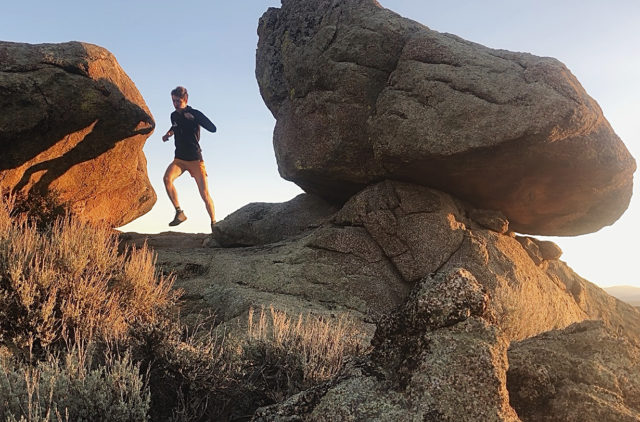
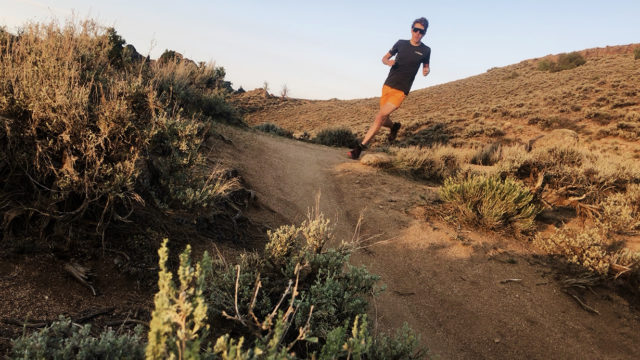
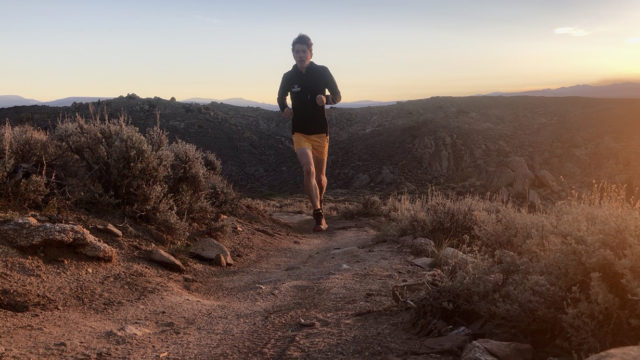
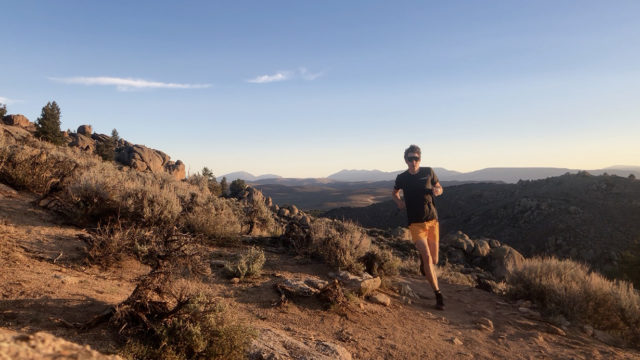
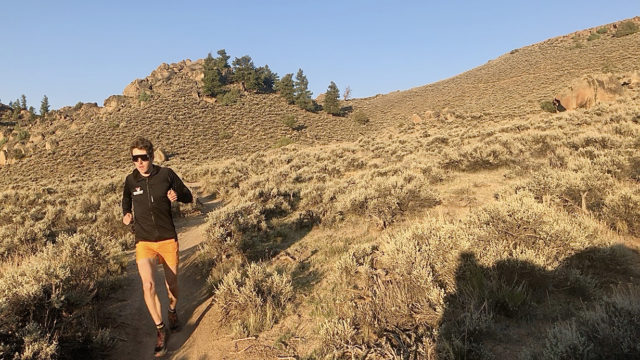
Hi there,
I see that you chose half a size up from Bushido II. Do you think a full size up would be a better choice?
I wore 44.5 in the original Bushido but felt a little bit short for longer runs. So I upped sizing to 45 in Bushido II. I am reluctant to buy a full size up (46) in Jackal, but trying it on is not an option at the moment. Thanks!
Stelios
Hi Stelios,
Good question. My pair of Bushido IIs was definitely at least a half size too small — in retrospect, I should have gotten a size 12 / EU 45.5 or maybe even a US 12.5 / EU 46 instead. For the Jackal, the US 12 / EU 45.5 felt just a hair short for longer days, so if I were to get another pair I’d probably go with a US 12.5 / EU 46. So long story short, I think going a half size up from the Bushido II is probably plenty— if anything, I think you could probably get away with getting the Jackal in the same size as the Bushido II if you feel like you’ve got plenty of room in those. Hopefully that’s helpful!
Hello ,
Definitely an issue with the heel. I got blisters after 20km in the achillean area. Also, the heel is not very stable for my feet.
regards,
Lucian.